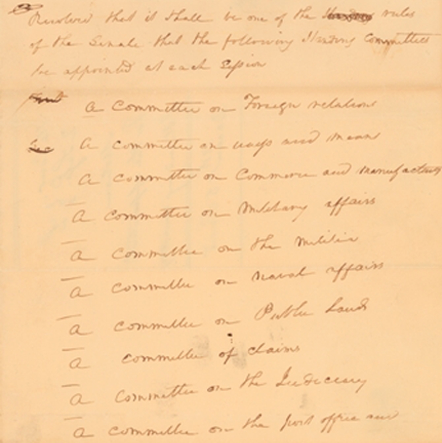Established in 1816 as one of the original standing committees in the United States Senate, the Senate Committee on the Judiciary is one of the most influential committees in Congress.
Its broad legislative jurisdiction has assured its primary role as a forum for the public discussion of social and constitutional issues. The Committee is also responsible for oversight of key activities of the executive branch, and is responsible for the initial stages of the confirmation process of all judicial nominations for the federal judiciary.
The Committee's Origin
The delegates to the Constitutional Convention of 1787 did not provide for congressional committees when they drafted the Constitution of the United States. Nevertheless, a select committee of eight Senators, often suggested to be the precursor to the present-day Judiciary Committee, was appointed one day after the Senate first convened in 1789. The select committee was tasked with drafting what would become the Judiciary Act of 1789. This landmark Act established the present three-tiered hierarchy of the federal judiciary, and the Office of the Attorney General.

1816 Senate Resolution
establishing the Standing Committees of the Senate
Center for Legislative Archives, National Archives and Records Administration
Temporary committees commonly convened in the House and Senate during the early years of Congress. The small size of Congress made it unnecessary to create permanent committees. In the Senate, ad hoc committees were comprised of three to five members depending on the issues assigned. These committees met as needed to discuss issues at their desks in the Senate chamber.
The rapid growth of the nation after the turn of the 19th century and the increase in the number of members of Congress resulted in greater complexity in the federal lawmaking process. Elected officials in both the Senate and House recognized that the legislative business of the rapidly expanding country could no longer be addressed within the structure of select committees. In a resolution adopted on December 10, 1816, the Senate established the body's original standing committees, including the Committee on the Judiciary. The House Judiciary Committee had been established three years earlier.
Committee Jurisdiction
In addition to its critical role in providing oversight of the Department of Justice and the agencies under the Department's jurisdiction, including the Federal Bureau of Investigation, and the Department of Homeland Security, the Judiciary Committee plays an important role in the consideration of nominations and pending legislation.
Executive nominations for positions in the Department of Justice, Office of National Drug Control Policy, the United States Parole Commission, the United States Sentencing Commission, and the State Justice Institute, as well as select nominations for the Department of Homeland Security and the Department of Commerce are referred to the Senate Judiciary Committee.
The Judiciary Committee is also charged with the consideration of all Article III judicial nominations. These include Supreme Court nominations, appellate court nominations, and district court nominations. The Committee also considers nominations to the Court of International Trade.
In addition to its role in conducting oversight and consideration of nominations, the Senate Judiciary Committee also considers legislation, resolutions, messages, petitions, memorials and other matters, as provided for in the Standing Rules of the Senate. These areas include:
- Apportionment of Representatives
- Bankruptcy, mutiny, espionage, and counterfeiting
- Civil liberties
- Constitutional amendments
- Federal courts and judges
- Government information Holidays and celebrations
- Immigration and naturalization
- Interstate compacts generally
- Judicial proceedings, civil and criminal, generally
- Local courts in territories and possessions
- Measures relating to claims against the United States
- National penitentiaries Patent Office Patents, copyrights, and trademarks
- Protection of trade and commerce against unlawful restraints and monopolies
- Revision and codification of the statutes of the United States
- State and territorial boundary lines